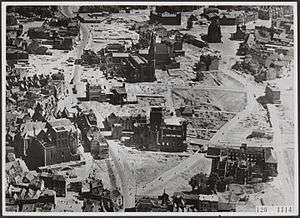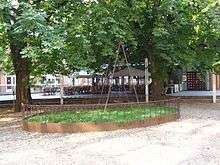Bombing of Nijmegen
| Bombing of Nijmegen | |||||||
|---|---|---|---|---|---|---|---|
| Part of World War II Operation Argument (Big Week) | |||||||
 Police photo from 1945: in the foreground, parts of the centre mainly bombed in February '44; most buildings in the background were not destroyed until Operation Market Garden (September 1944).[1] | |||||||
| |||||||
| Belligerents | |||||||
|
|
| ||||||
| Casualties and losses | |||||||
| Railway station heavily damaged | |||||||
| c. 800 civilian casualties | |||||||
The Bombing of Nijmegen was an unplanned bombing attack by American aircraft on the city of Nijmegen in the Netherlands on 22 February 1944. In terms of the number of victims, it was one of the largest bombardments of a Dutch city during World War II. Officially, almost 800 people were killed, but because people that were in hiding could not be counted, the actual figure is probably higher. A large part of the historic city centre was destroyed, including Saint Steven's Church. Saint Augustine's Church and Nijmegen railway station (the intended target[3]) were heavily damaged as well.
Background
The planned raid was part of the so-called 'Big Week' (official name: Operation Argument), a series of allied bombardments on German aircraft factories to considerably weaken the Luftwaffe in preparation of D-Day (June 1944). On 20 and 21 February, the first bombings had been carried out.[2][4]
At the time, it was common within the allied airforce to attack secondary targets if due to circumstances the primary target could not be reached. These secondary targets were called targets of opportunity.[3][4] Because a bombing raid was risky and expensive (because of enemy fire and fuel), and the main target could often not be hit, an opportunistic bombardment could still deal an important blow to the enemy, thus turning the operation into a partial success, and partly rewarding the stakes.[3] The railway station area of Nijmegen was marked as such a target of opportunity, because it was well-known at the time that the Germans were using it for weapons transport.[3][4] Moreover, there was pressure on the flyers to bomb anything if possible, because it was unsafe to land with unexpended bombs, and once the flyers had carried out 25 raids, they were given leave of absence.[2]
Course of events
At 8:00 in the morning of 22 February, 177 American B-24 Liberator bombers, escorted by dozens of fighters of the types P-38 Lightning, P-47 Thunderbolt and P-51 Mustang,[5] took off from RAF Bungay airbase near the Suffolk village of Flixton.[2] They flew in the direction of the German city of Gotha, where the Gothaer Waggonfabrik aircraft factory was producing Messerschmitt fighters and other Luftwaffe planes. This required a four hour flight over German territory, making it an extraordinarily dangerous mission.[2] If Gotha could not be reached, Eschwege was the next target, and if even that failed, the pilots had to seek out a target of opportunity in Germany themselves on the way back to Britain.[2]
Because the clouds were floating unusually high that day, the aircraft had trouble properly gathering into formation, and quickly lost sight of each other. Therefore, a considerable number of bombers already broke off their mission just 15 minutes after take-off and returned.[2] Even while still above the North Sea, the Americans were unexpectedly fired on by German fighters. When the group passed by Nijmegen earlier that day, the air raid siren was activated, and the people of Nijmegen ran for cover in their shelters until the coast was clear.[2] Shortly after, around 12:00 when the bombers had passed the Dutch–German border by about 10 miles, they received a message from command that the raid had to be cancelled due to too heavy cloud formations above Gotha for an effective bombardment; the units were recalled to England. Because Eschwege was still far out of reach as well, looking for targets of opportunity on the way back was now recommended.[2]
It was an extremely difficult task to turn around hundreds of planes that had to stay in formation, leading to a huge chaos in the air and fragmenting the group into several squadrons who each sought their way back to Britain for themselves. Underway, they looked for targets of opportunity, and eventually the Dutch cities of Nijmegen, Arnhem, Deventer and Enschede were selected and attacked.[2] Beforehand, the flyers had been poorly informed about whether Nijmegen was a Dutch or a German city, whether German-occupied cities could or couldn't be bombed, and if so in what way, and they were negligent in finding out exactly which cities they were about to strike,[3] partly due to miscommunication that can be ascribed to technical problems such as a stuck radio operator's morse key.[2]
For reasons that are still unclear, the air raid siren was not activated a second time when a division of the aircraft returned in Nijmegen's airspace, causing the citizens not to run for cover as quickly as possible in time.[2] 144 bombs were dropped, each weighing 500 pounds.[2] The actual target of opportunity, the train station terrain, was successfully hit. However, a considerable part of the bombs fell on the city centre in residential areas, destroying homes, churches and other civil targets, killing hundreds of innocent and unarmed civilians.[3] After the fact, official Allied sources claimed that the pilots thought they were still flying above Germany, and had misidentified Nijmegen as the either the German city of Kleve (Cleves) or Goch. Yet some flyers themselves stated just an hour after landing in England that they had bombed Nijmegen, and a navigator even reported this in the air moments after the raid.[3]
Legacy

The Nazis reported that the Dutch government-in-exile in London had giving permission for the airstrike on Nijmegen, and that it therefore was an intentional bombardment.[2] They made passionate attempts to exploit the bombing for propaganda: in public places, posters were hung with texts such as 'With friends like that, who needs enemies?' and 'Anglo-American Terror'. The German-controlled newspapers furiously rebuked the Allies and the Dutch government-in-exile as well, one remarking "The Anglo-American pirates of the sky have once again executed the orders of their Jewish-Capitalist leaders with extraordinarily positive results". However, it looks like the propaganda was ineffective: seven months later, the American ground troops were welcomed as heroes by the inhabitants. Internal sources of the occupying government's Department for Popular Education and Arts even suggest the propaganda may have been counterproductive.[2]
The American army command was relatively late in drawing lessons from the disorderly conducted air raid, which had struck an ally's civilian population hard. Not until mid-May 1944, orders were given to seek out targets of opportunity at least 30 kilometres away from the Netherlands' border.[3]
The Allied bombing of Nijmegen claimed almost as many civilian casualties as the German bombing of Rotterdam at the start of the war, but it isn't given nearly as much attention.[2] The population of Nijmegen was told not to express their emotions, because the bombardment had been carried out by a befriended nation. Furthermore, it was officially maintained that it was an 'erroneous bombardment' (vergissingsbombardement), and the fact that the railway station area was indeed actually the intended target of opportunity, was covered up.[3] In 1984, a memorial service was held for the first time, and at the 1994 Nijmegen Storytelling Festival amidst great public interest, eyewitnesses and survivors were given the chance to speak after 50 years of silence.[2] Not until 2000, a monument was erected for the civilian casualties:[3] 'De Schommel' (The Swing) at the Raadhuishof. Annual memorial gatherings held on 22 February were attended by an increasing amount of people in the 2010s.[6]
Investigation
Up to this day, there is no definitive conclusion about the causes and motives for the bombing. For a long time, the attack was presumed to have been an 'error', but it was not until 2006 that an investigation revealed that Nijmegen was a so-called target of opportunity for Allied bombers. In his 2009 study, history docent Joost Rosendaal of Radboud University Nijmegen classified it as an opportunistic bombing rather than an error. Rosendaal rejects the notion of an 'error', because the Americans were negligent in properly identifying which city to bomb. The Americans "intentionally bombed a target of opportunity, that however had not been unambiguously identified."[3]
Rosendaal added that the death toll was further increased by several disastrous circumstances. The switchboard operator, who normally directed emergency services, was killed during the raid, and without her communications went much slower. Many water pipes had been destroyed, making firefighting efforts much harder and more time-consuming. Dozens of people were still alive, but stuck under the rubble; many burnt to death when spreading flames reached them before they could be extinguished.[3]
-
Daalseweg cemetery, victim monument 22-02-44.
-
Daalseweg cemetery, grave of Leo Jacobs, signaller of Saint Steven's Tower, 22-02-'44.[1]
-
Daalseweg cemetery, chapel with a list of child victims 22-02-'44
-
Daalseweg cemetery, chapel with a list of nurse victims JMJ_22-02-'44
-
Daalseweg cemetery, two rows of war victim graves 22-02-'44
-
Saint Steven's Church bombing plaquette 22-02-'44
-
Graafseweg cemetery, monument 22-02-'44
References
- ↑ Historische @tlas Nijmegen
- 1 2 3 4 5 6 7 8 9 10 11 12 13 14 15 16 17 "Bombardement van Nijmegen". Andere Tijden. NPO Geschiedenis. 20 January 2004. Retrieved 20 August 2016.
- 1 2 3 4 5 6 7 8 9 10 11 12 13 14 "Bombardement geen vergissing, wel een 'faux pas'". De Gelderlander. 21 February 2009. Retrieved 20 August 2016.
- 1 2 3 "Bombardement 22 februari 1944 Nijmegen". Oorlogsdoden Nijmegen. Retrieved 20 August 2016.
- ↑ Jack McKillop. "Combat Chronoloy of the US Army Air Forces February 1944". USAAF Chronology. Retrieved 20 August 2016.
- ↑ "Steeds drukker bij herdenking bombardement Nijmegen". De Gelderlander. 22 February 2016. Retrieved 21 August 2016.
Literature
- Joost Rosendaal Nijmegen '44. Verwoesting, verdriet en verwerking, uitg. Vantilt, Nijmegen (2009)
- Onno Havermans "Het bombardement was geen vergissing - Nijmegen leed zwaar onder de oorlog", Trouw, cahier Letter&Geest, 28 March 2009, p. 81.
External links
- Rapport Vooronderzoek bombardement Nijmegen 22 februari 1944, November 2004
- Online publication of the book De fatale aanval by Alfons E. Brinkhuis, 1984
- Video about the victims' funeral, 1944
- Video of the 1944 bombing
- Oorlogsdoden Nijmegen 1940-1945